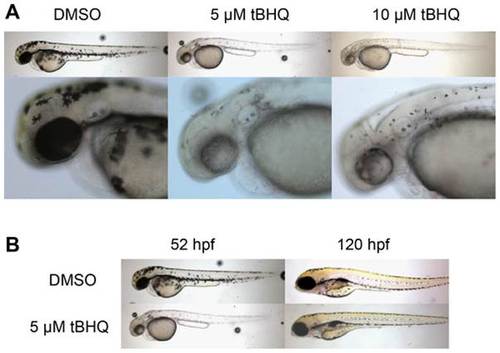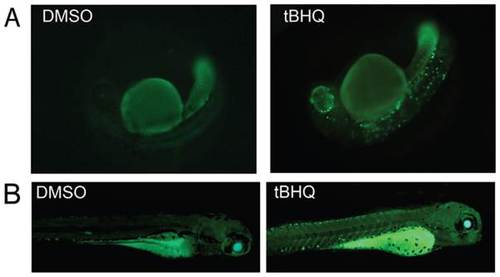- Title
-
The Transcriptional Response to Oxidative Stress during Vertebrate Development: Effects of tert-Butylhydroquinone and 2,3,7,8-Tetrachlorodibenzo-p-Dioxin
- Authors
- Hahn, M.E., McArthur, A.G., Karchner, S.I., Franks, D.G., Jenny, M.J., Timme-Laragy, A.R., Stegeman, J.J., Woodin, B.R., Cipriano, M.J., Linney, E.
- Source
- Full text @ PLoS One
|
Phenotypic changes following tBHQ exposure. Zebrafish embryos were exposed to tBHQ (5 or 10 µM) or 0.1% DMSO from 32–47 hpf. A. At 52 hpf, randomly selected embryos were mounted in 3% methylcellulose and imaged as described in Materials and Methods. B. Embryos were subsequently maintained in 0.3× Danieau′s water (without tBHQ) at until 120 hpf, when they were imaged again in order to assess recovery of pigmentation. |
|
EGFP-HSP70 zebrafish exposed to tBHQ A. Embryos from hsp70-EGFP transgenic zebrafish were exposed to DMSO (0.1%) or tBHQ (10 µM) for 4 hrs at 1-dpf. After exposure, embryos were washed and held for 4 additional hours prior to fluorescence microscopy for detecting EGFP expression. B. Another experiment was performed by exposing 4-dpf eleutheroembryos (n = 15) to DMSO (0.1%) or tBHQ (10 µM) for 4 hrs at 28°C. After exposure, eleutheroembryos were washed with 0.3× Danieau′s and inspected 4 hrs post-exposure for EGFP expression by fluorescence microscopy. |


